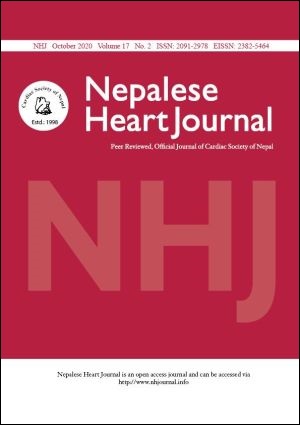Association of High Sensitivity C-Reactive Protein with In-Hospital Mortality in Patients with Acute St-Segment Elevation Myocardial Infarction
DOI:
https://doi.org/10.3126/njh.v17i2.32676Keywords:
Acute ST elevation myocardial infarction, in-hospital mortality, serum level of hs-CRPAbstract
Background and Aims: Among the various biomarkers, high sensitivity C-Reactive Protein (hs-CRP) has been widely studied and is easy to use in the prognostication of patients with acute ST elevation myocardial infarction (STEMI). This study aimed to associate serum level of hs-CRP with in-hospital mortality in patients presented with acute STEMI.
Methods: This was a hospital-based prospective observational study conducted in Shahid Gangalal National Heart Centre among patients presented to the emergency department with chest pain of less than 24 hours duration, who were diagnosed subsequently to have STEMI. Patients who had known chronic inflammatory diseases, septic foci and chest pain of over 24 hours were excluded from the study. Blood sample for Hs-CRP was sent from the emergency department and was measured with Finecare TM FIA system; Model number: FS-112. The study was conducted from April 2019 to March 2020. Patient outcomes were stratified as per the four groups of serum level of hs-CRP and among them the relationship between mortality and hs-CRP level was tested with chi-square test. The p-value across the groups was again tested for inter-group significance using the Bonferroni adjusted significance level.
Results: 140 patients (112 males and 28 females) with mean age of 58.1±14.86 years were enrolled in the study. There was no increased in-hospital mortality in acute STEMI patients who had serum level of hs-CRP below 3 mg/l. In-hospital mortality showed an increasing trend above this level but it reached statistical significance beyond 10 mg/l only. Thirty five percent of our patients of acute STEMI were found to have serum level of hs-CRP above this threshold. The total in-hospital mortality was 13 (9.28%).
Conclusion: The increased serum level of hs-CRP was associated with increased in-hospital mortality in patients with acute STEMI.
Downloads
Downloads
Published
How to Cite
Issue
Section
License
This license enables reusers to distribute, remix, adapt, and build upon the material in any medium or format, so long as attribution is given to the creator. The license allows for commercial use.




